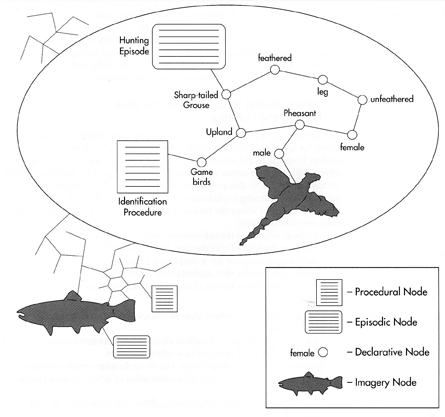
A network model of LTM
There are at least two important insights for educators related to long term memory. The first is that long term memory stores different types of information. Most academic and life tasks require the use of several categories of memory contents. Presumably, then, our various elements of memory are organized in a meaningful way. It turns out that this may or may not be the case. This is the second important insight. Individuals connect elements in their memories in unique ways as a consequence of personal cognitive activity. Effective educational experiences, therefore, must result in both the accumulation and organization of memory units. We call this organized structure of memory units a network.
The network is a useful way to conceptualize how what we know, the content of our memory, is stored and the ways memory works. Network models represent memory in terms of nodes, which are cognitive units, and links, which establish the relationships among nodes (Anderson, 1983; Collins & Quillian, 1969).
The figure that follows is a graphic representation of what such models attempt to describe. This representation portrays a small part of a high-school biology student's knowledge. Included are examples of the four categories of LTM contents:
- Imagery: recollection of animals the student has seen
- Episodic knowledge: the recollection of a hunting trip
- Declarative knowledge: conceptual knowledge about pheasants and grouse
- Procedural knowledge: the stored strategy for identifying particular game birds

As you can see from the figure, these elements are liked in meaningful ways. For example, the image of a male pheasant is connected with the concepts "male" and "pheasant".
The network-like structure of memory explains an important characteristic of human thought. We seldom recall isolated thoughts. One idea seems to make us aware of other ideas, images, and stored experiences. The related nodes that are first activated or brought into our awareness are those that are the most directly linked. Many important kinds of of mental performance depend on how individual nodes of memory are linked or organized. Organized elements of memory are more likely to be available to our awareness at any given point than are unorganized elements. Attempting to recall disconnected elements requires additional working memory capacity. Mental tasks will go much more successfully when the memory elements necessary to accomplish them are well organized.
If LTM consists of a network of nodes, then a major goal of education is to construct and modify this network. One important way to modify the network is to add new nodes (ideas, events, images, or procedures). However, it is also important to organize nodes by adding new links and possibly by eliminating other, inappropriate nodes. Creating links is not an automatic process. Students must activate stored experiences and find appropriate connections with new ideas or with older ideas that were not previously understood as related. How all this happens is not fully understood, but we do know that elements to be linked must be simultaneously activated (brought into working memory).
One final comment about links. It appears that knowledge can be linked to context. In our discussion of inert knowledge, we noted that it appears that we may store multiple, partially contradictory explanations (models) that explain life experiences and the explanation activated may depend on the context. This challenge has been studied most extensively in connection with science education , but likely applies to a wide variety of explanations for how things work. In order for flawed models of how something works to be changed, the flawed model must be activated (brought into working memory) at the same time information that contradicts the flawed model is active. This is called cognitive conflict and evidently the links necessary to locate flawed models and generate cognitive conflict do not activate automatically when potentially contradictory ideas are presented in classrooms (Limon, 2001).
So, how can classroom experiences generate the cognitive conflict that is sometimes necessary to combat flawed understanding? Getting students to predict, observe, and then account for actual events provides one strategy. Using what they know, students make a prediction. For example, students may predict that the voltage will differ between the two wires leading to a light bulb because the current flowing to the light is used up in creating light. When this outcome is not observed student can be asked to account for the error in their prediction. Demonstrations or simulations offer this opportunity. Of course, technology offers ways to provide demonstrations and simulations. Here is one situation in which experiential activities have an advantage over direct instruction. Students play an active role in the process increasing the probability flawed ideas will be surfaced and modified. Other techniques do work. Chi (2000) argues that asking students to explain processes that are frequently misunderstood increases the chances learners will modify flawed understanding. The key appears to be to create circumstances in which students must activate and use existing knowledge and in doing so may identify flaws. Authoring and teaching to learn, methods for encouraging active use of personal knowledge we explore here, are based on similar assumptions to what Chi calls self-explanation.
